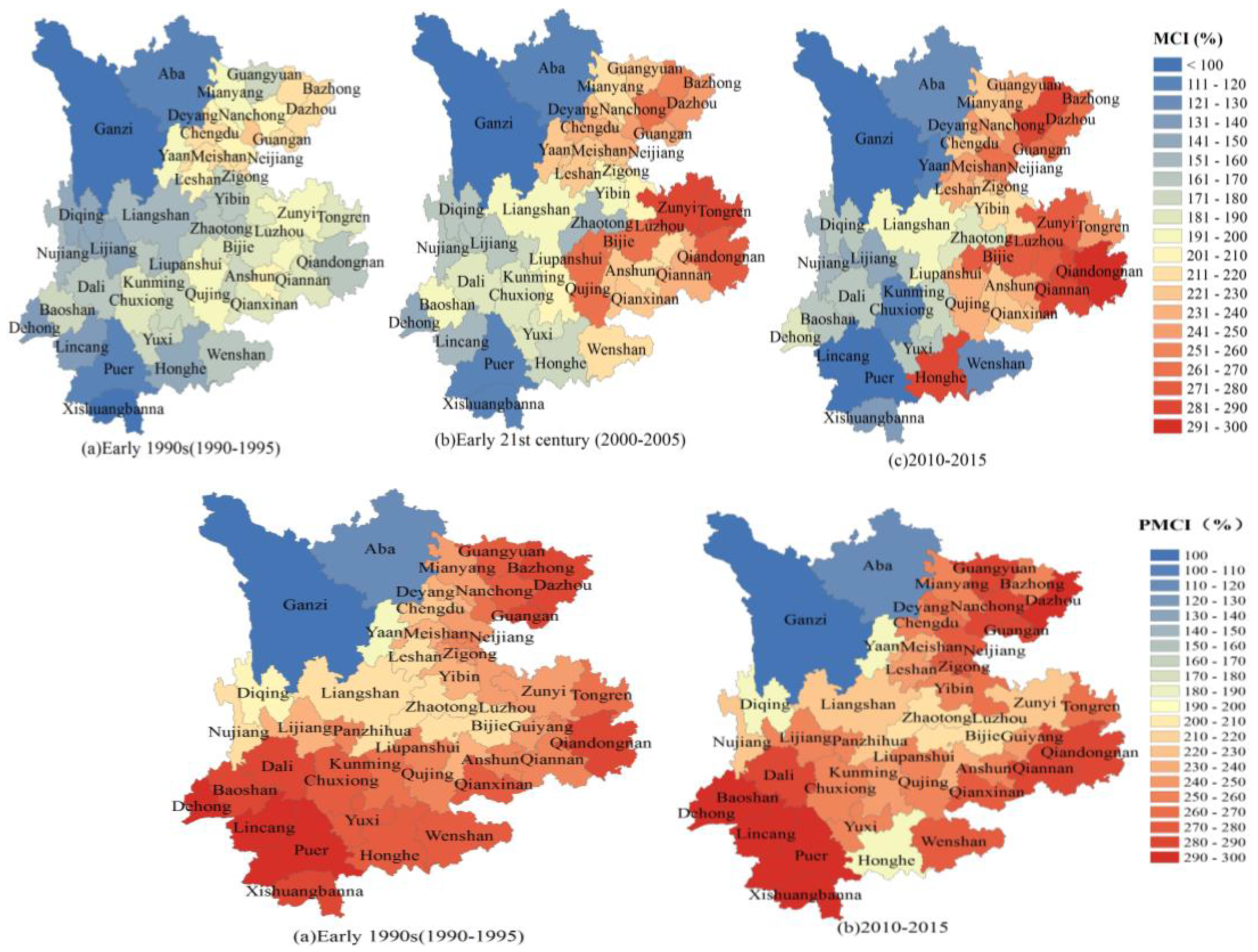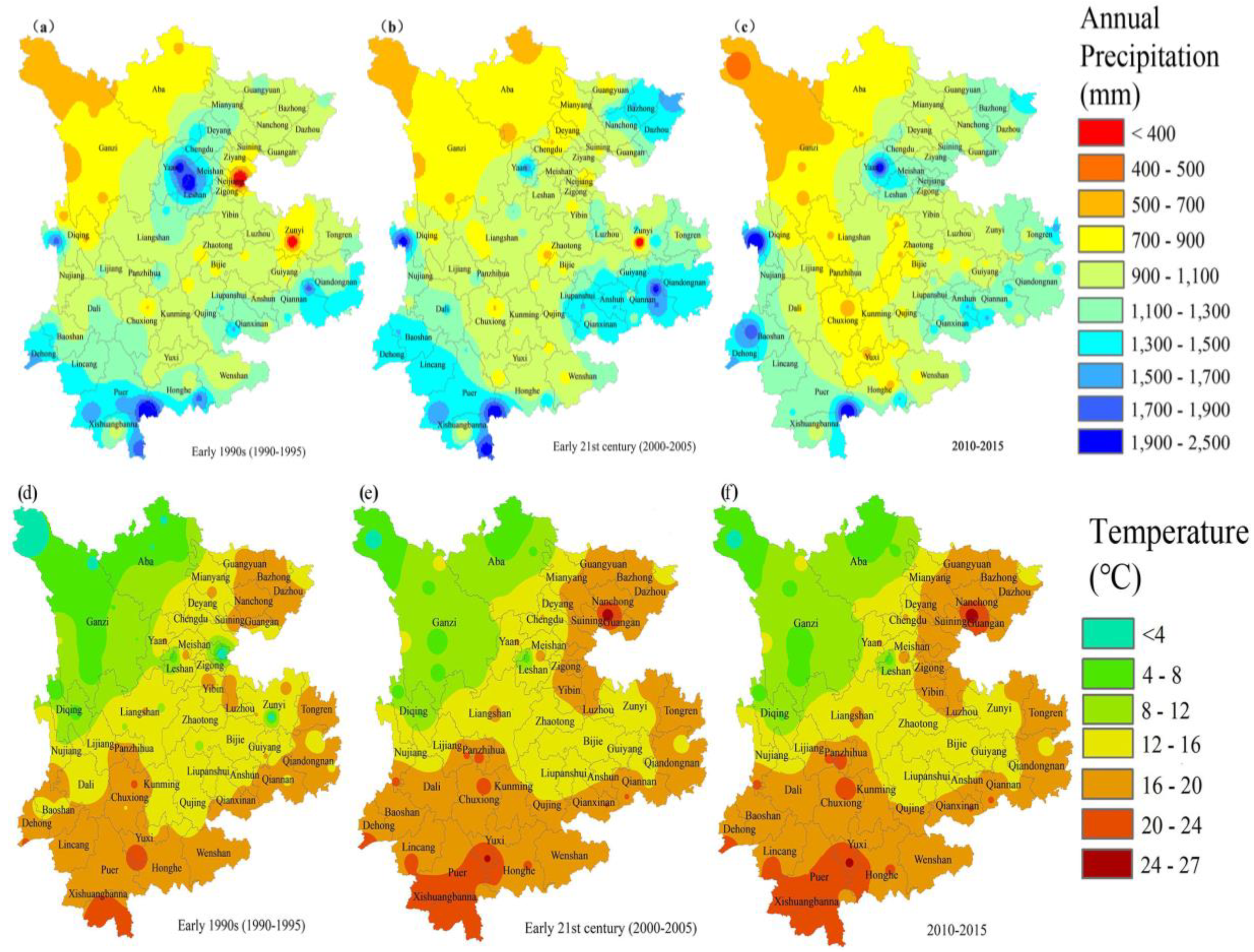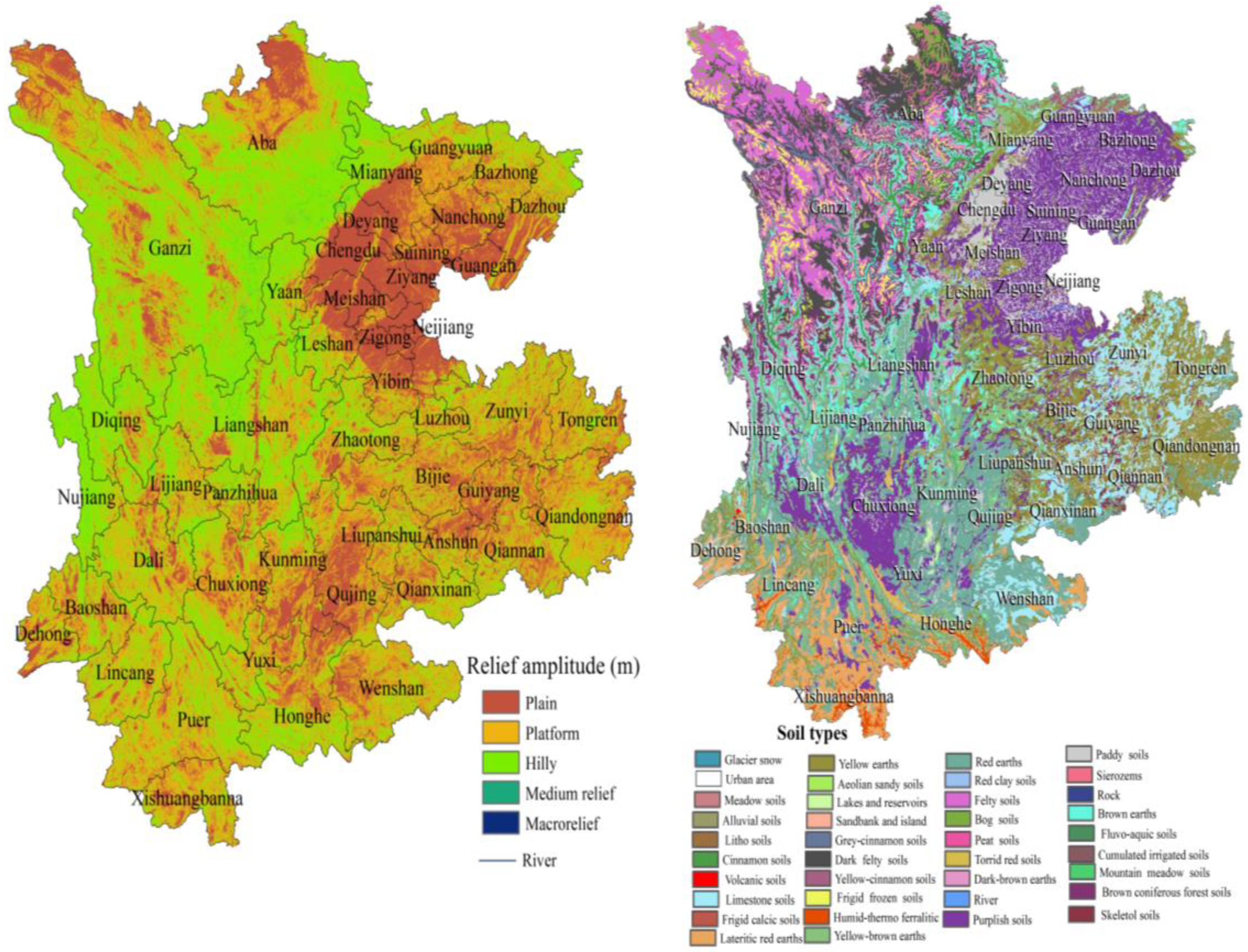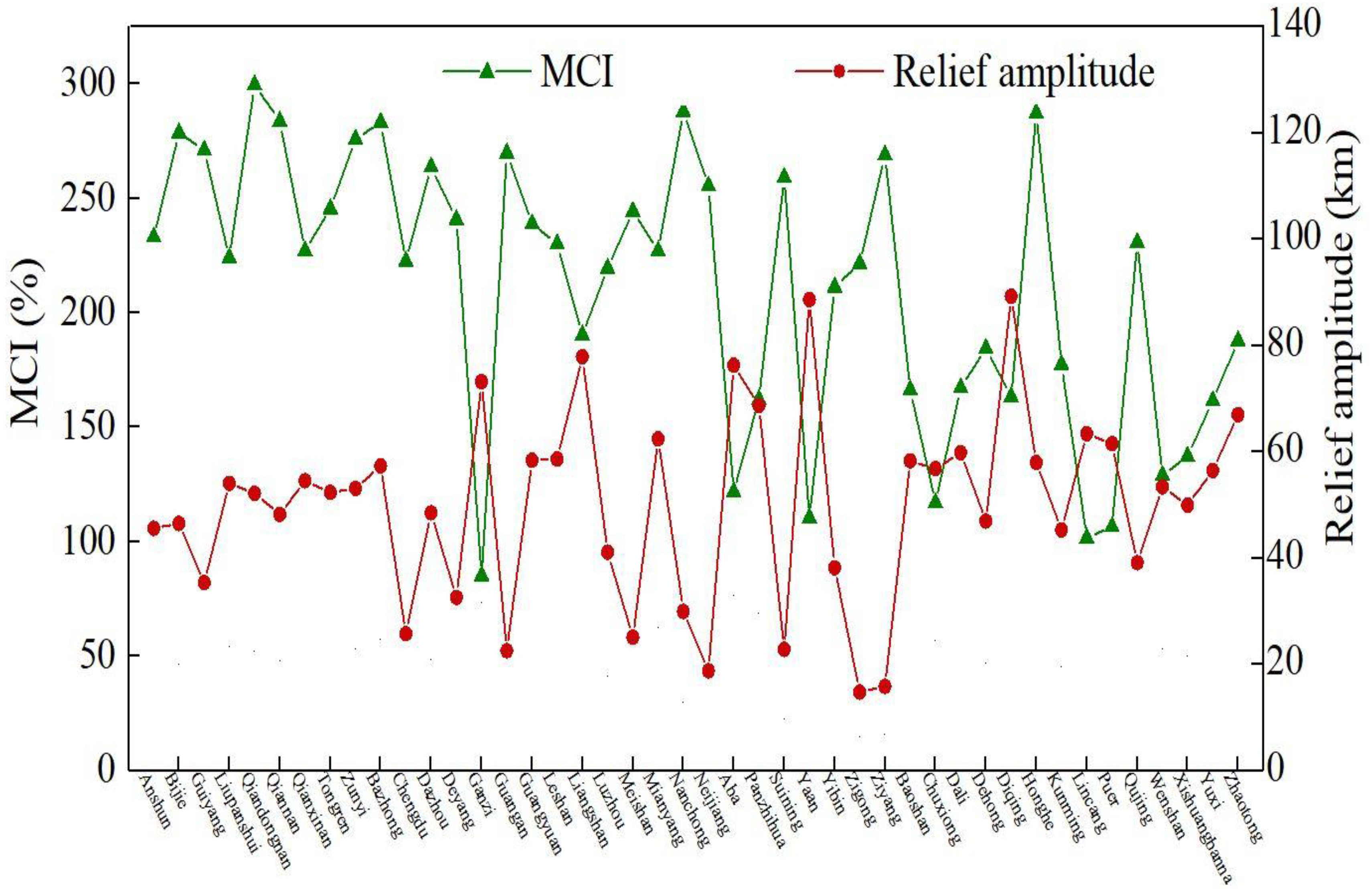The Impact of Climate Change and Human Activity on Spatiotemporal Patterns of Multiple Cropping Index in South West China
Abstract
:1. Introduction
2. Materials and Methods
2.1. Study Area
2.2. Data Set
2.3. Statistical Analysis of Spatiotemporal Distribution Patterns
2.4. Methods
3. Results
3.1. The Change in Time Series of MCIs for Different Crops
3.2. Spatial Distribution Characteristics
3.2.1. Analysis of the Spatial Pattern Change in MCI
3.2.2. Analysis of the Spatial Pattern of the Change in the PMCI
3.2.3. Analysis of the Spatial Pattern of the Change in the PIMCI
4. Discussion
4.1. Impact of Climate Change on the MCI
4.2. Impact of Human Activities on the MCI
4.2.1. Impact of Land Use and Cover Changes
4.2.2. Impact of Socioeconomic Development
4.3. The Influence of Terrain Factors on the MCI
5. Conclusions and Policy Suggestions
5.1. Conclusions
- (1)
- Temporal characteristics of the variations in the MCI: In Yunnan Province, the MCI showed a fluctuating downward trend with sudden declines in Guizhou Province from 2004–2006 and 2012–2014, while in Sichuan Province, it exhibited an increasing trend. The grain crop MCI was roughly divided into two stages, from 1990 to 2006, it decreased slowly in Yunnan but the downward trend was sharp in 2000, while both Guizhou and Sichuan provinces showed increasing trends, with the growth rate in Sichuan being relatively slow. The greatest change in the three provinces occurred from 2006 to 2015. The inter-annual variations in the grain crop MCIs were as follows: Sichuan > Guizhou > Yunnan, with values of −41.01%, −33.55%, and −29.60%, respectively. In contrast, the cash crop MCI has maintained a steady growth trend in recent years.
- (2)
- Spatial characteristics of the variations in the MCI: The internal distribution of the MCI in the southwestern region as a whole was high in the east and low in the west throughout the study period. Moreover, the MCI was higher in the central region than in the northern and southern regions. Particularly, from the early 1990s to the early 21st century, the MCI increased in most areas of the three provinces, and the increase was particularly obvious in Guizhou Province, while in the early 21st century, the MCI of each city and state in the three provinces reached the maximum value. In 2010–2015, the MCI declined in most areas of Sichuan Province, especially in Chengdu and its surrounding areas. In the southern part of Yunnan Province, the MCI was the lowest in Xishuangbanna and Pu’er city, and the phenomenon of abandoned farmland was more serious in these areas. The overall level of arable cropping in Yunnan Province was lower than that in Guizhou Province and Sichuan Province.
- (3)
- For the PMCI, the spatial differences in the PMCI in southwest China were obvious, and the temporal differences were not significant. In the early 1990s and 2010–2015, the PMCI was significantly higher in the eastern and southern regions than in the central and northwestern regions. The PMCI was largest in the eastern part of Sichuan, which was much higher than that in the western region. The PMCI was relatively large in all regions of Yunnan due to the large space for the full utilization of light, heat, and water resources. Over the past 25 years, as climate warming continued to increase, the average PMCI for all Sichuan showed an increasing trend, except in Bazhong in the eastern part of Sichuan, which exhibited a decreasing trend. However, the PMCI in the eastern part of Yunnan showed a declining trend, especially in Honghe, and other regions maintained high potential. In contrast, the changes in the other cities in Guizhou Province were not significant over the past 25 years, except for the obvious changes in Qiannan and Zunyi. The PIMCI values in Yunnan Province were significantly higher than those in Guizhou and Sichuan provinces, especially in the southern part of Yunnan, which was the smallest area with high potential in Guizhou Province. However, Yunnan Province was rich in water and heat resources, but the overall utilization of cultivated land was inefficient.
- (4)
- Factors influencing the MCI: Climate change and natural disasters had a certain influence on the MCI changes in southwest China, especially temperature changes, which was the key factor driving the MCI changes. The temporal and spatial changes in land use, such as farmland and urbanization, played a vital role in influencing the dynamic changes in the MCI. The spatial variations in the MCI were closely related to the terrain, as the MCI in the hilly area decreased, and the MCI in the plain area increased.
5.2. Policy Suggestions
- (1)
- The trend of the MCI in southwest China decreased, especially after 2006, due to environmental problems such as floods, serious drought, and extreme temperatures, which impacted the infrastructures of farmland, water conservation, transportation, and urbanization; thus, the government and policy makers should devote more concern to the development of production conditions and water-saving technology to conserve water resources in the rainy seasons and relieve drought in the dry seasons. Furthermore, the government must support rain-flood utilization, seawater desalination, and effective drought management practices to face future water resource shrinkages.
- (2)
- The variations in the MCI in southwest China are mostly due to the differences between the three provinces, which including differences in the water resource, heat, fertilizer, and farmland characteristics. The MCI exhibited a slight decreasing trend, especially in Yunnan Province, due to the labor shortage problems and cost of farm production. Therefore, the government should pay attention to the promotion of science and technology to solve the labor shortage problems by accelerating the construction of labor-saving technology, implementing large-scale operations, agricultural mechanization, and farmland management. China’s science and technology promotion rate is currently only approximately 35%, with large room for development.
- (3)
- Both non-agricultural industry and per capita farmland have strong positive effects on the MCI, so policy makers should transfer the excess rural labor to the secondary and tertiary industries, alleviate pressure on farmlands, and raise the gross farm production, which will ultimately support farmers in less developed regions and increase the grain production and MCI in southwest China [53].
Author Contributions
Funding
Conflicts of Interest
References
- Yang, H.; Li, X. Cultivated land and food supply in China. Land Use Policy 2000, 17, 73–88. [Google Scholar] [CrossRef]
- Pan, G.X.; Gao, M.; Hu, G.H.; Wei, Q.P.; Zou, J.W. Impacts of climate change on agricultural production of China. J. Agro Environ. Sci. 2011, 30, 1698–1706. (In Chinese) [Google Scholar]
- Ju, X.G.; Qiang, Z.; Jing, W. Impact of global climate change on agro-ecosystem:A review. Chin. J. Appl. Ecol. 2007, 18, 1877–1885. (In Chinese) [Google Scholar] [CrossRef]
- Xie, H.; Wang, P.; Yao, G. Exploring the dynamic mechanisms of farmland abandonment based on a spatially explicit economic model for environmental sustainability: A case study in Jiangxi Province, China. Sustainability 2014, 6, 1260–1282. [Google Scholar] [CrossRef]
- Ali, A.M.S. Population pressure, agricultural intensification and changes in rural systems in Bangladesh. Geoforum 2007, 38, 720–738. [Google Scholar] [CrossRef]
- Lichtenberg, E.; Ding, C. Assessing farmland protection policy in China. Land Use Policy 2008, 25, 59–68. [Google Scholar] [CrossRef]
- Keys, E.; McConnell, W.J. Global change and the intensification of agriculture in the tropics. Glob. Environ. Chang. 2005, 15, 320–337. [Google Scholar] [CrossRef]
- Lin, G.C.; Ho, S.P. China’s land resources and land-use change: Insights from the 1996 land survey. Land Use Policy 2003, 20, 87–107. [Google Scholar] [CrossRef]
- Dalrymple, D.G. Survey of Multiple Cropping in Less Developed Nations; Economic Research Service: Washington, DC, USA, 1971. [Google Scholar]
- Erb, K.H.; Haberl, H.; Jepsen, M.R.; Kuemmerle, T.; Lindner, M.; Müller, D.; Verburg, P.H.; Reenberg, A. A conceptual framework for analysing and measuring land-use intensity. Curr. Opin. Environ. Sustain. 2013, 5, 464–470. [Google Scholar] [CrossRef] [Green Version]
- Yu, Q.; Van Vliet, J.; Verburg, P.H.; You, L.; Yang, P.; Wu, W. Harvested area gaps in China between 1981 and 2010: Effects of climatic and land management factors. Environ. Res. Lett. 2018, 13, 044006. [Google Scholar] [CrossRef]
- Ray, D.K.; Foley, J.A. Increasing global crop harvest frequency: Recent trends and future directions. Environ. Res. Lett. 2015, 8, 044041. [Google Scholar] [CrossRef]
- Turner, B.L.; Doolittle, W.E. The Concept and measure of agricultural intensity. Prof. Geogr. 1978, 30, 297–301. [Google Scholar] [CrossRef]
- Zuo, L.; Xiao, W.; Zhang, Z.; Zhao, X.; Fang, L.; Ling, Y.; Liu, B. Developing grain production policy in terms of multiple cropping systems in China. Land Use Policy 2014, 40, 140–146. [Google Scholar] [CrossRef]
- Xu, X.B.; Yang, G.S.; Li, H.P. Impacts of Land Use Change on Net Primary Productivity in the Taihu Basin, China. Resour. Sci. 2011, 33, 1940–1947. (In Chinese) [Google Scholar]
- Tang, P.; Wu, W.; Yao, Y.; Yang, P. New method for extracting multiple cropping index of North China Plain based on wavelet transform. Trans. Chin. Soc. Agric. Eng. 2011, 27, 220–225. (In Chinese) [Google Scholar]
- Wu, W.; Yu, Q.; You, L.; Chen, K.; Tang, H.; Liu, J. Global cropping intensity gaps: Increasing food production without cropland expansion. Land Use Policy 2018, 76, 515–525. [Google Scholar] [CrossRef]
- Verburg, P.H.; Chen, Y. Spatial explorations of land use change and grain production in China. Agric. Ecosyst. Environ. 2000, 82, 333–354. [Google Scholar] [CrossRef]
- Ikenaga, S.; Inamura, T. Evaluation of site-specific management zones on a farm with 124 contiguous small paddy fields in a multiple-cropping system. Precis. Agric. 2008, 9, 147–159. [Google Scholar] [CrossRef]
- Frolking, S.; Yeluripati, J.B.; Douglas, E. New district-level maps of rice cropping in India: A foundation for scientific input into policy assessment. Field Crops Res. 2006, 98, 164–177. [Google Scholar] [CrossRef]
- Xiang, M.; Yu, Q.; Wu, W. From multiple cropping index to multiple cropping frequency: Observing cropland use intensity at a finer scale. Ecol. Indic. 2019, 101, 892–903. [Google Scholar] [CrossRef]
- Dash, J.; Mathur, A.; Foody, G.M.; Curran, P.; Chipman, J.; Lillesand, T. Land cover classification using multi-temporal MERIS vegetation indices. Int. J. Remote Sens. 2007, 28, 1137–1159. [Google Scholar] [CrossRef]
- Thenkabail, P.S.; Schull, M.; Turral, H. Ganges and Indus river basin land use/land cover (LULC) and irrigated area mapping using continuous streams of MODIS data. Remote Sens. Environ. 2005, 95, 317–341. [Google Scholar] [CrossRef]
- Gao, M.J. Safety Threshold of Arable Land Based on Demand of Agricultural Comprehensive Production Capacity; Chinese Academy of Agricultural Sciences: Beijing, China, 2008. (In Chinese) [Google Scholar]
- Ding, M.; Chen, Q.; Xin, L.; Li, L.; Li, X. Spatial and temporal variations of multiple cropping index in China based on SPOT-NDVI during 1999–2013. Acta Geogr. Sin. 2015, 70, 1080–1090. [Google Scholar] [CrossRef]
- Yan, H.M.; Liu, J.Y.; Cao, M.K. Remotely Sensed Multiple Cropping Index Variations in China during 1981–2000. Acta Geogr. Sin. 2005, 60, 559–566. (In Chinese) [Google Scholar]
- Liu, L.; Xu, X.L.; Zhuang, D.F.; Chen, X.; Li, S. Changes in the potential multiple cropping system in response to climate change in china from 1960–2010. PLoS ONE 2013, 8, e80990. [Google Scholar] [CrossRef] [PubMed]
- Yu, Q.Y.; Xiang, M.T.; Xie, A.K. Cropping intensity gap: A review. China Agric. Inform. 2018, 30, 1–12. (In Chinese) [Google Scholar]
- Fan, J.L.; Wu, B.F. A Study on Cropping Index Potential Based on GIS. J. Remote Sens. 2004, 8, 637–644. (In Chinese) [Google Scholar] [CrossRef]
- He, W.S.; Wu, W.B.; Yu, Q.Y. From 1980 to 2010, the spatial pattern of multiple planting of cultivated land in China was changed. Agric. Resour. Reg. China 2016, 37, 7–14. (In Chinese) [Google Scholar] [CrossRef]
- Yu, Y.S.; Nu, T. On the Crisis of Urban Characteristics under the Background of Urbanization. Sci. Technol. Innov. 2011, 26, 142. [Google Scholar]
- Zhao, Y.G. Changing Characteristics and Developmental Potentials on Multiple Cropping Index of Arableland in Southwestern China. Res. Agric. Mod. 2010, 31, 100–104. (In Chinese) [Google Scholar] [CrossRef]
- Huang, G.Q. On the increase of multiple cropping index of cultivated land in southern China. Resour. Sci. 1995, 1, 30–37. (In Chinese) [Google Scholar]
- Liu, M.; Xu, X.; Sun, A. Decreasing spatial variability in precipitation extremes in southwestern China and the local/large-scale influencing factors. J. Geophys. Res. Atmos. 2015, 120, 6480–6488. [Google Scholar] [CrossRef]
- Liu, M.; Xu, X.; Sun, A.Y.; Wang, K.; Liu, W.; Zhang, X. Is southwestern China experiencing more frequent precipitation extremes? Environ. Res. Lett. 2014, 9, 064002. [Google Scholar] [CrossRef] [Green Version]
- Mann, H.B. Nonparametric Tests Against Trend. Econometrica 1945, 13, 245–259. [Google Scholar] [CrossRef]
- Hamed, K.H. Trend detection in hydrologic data: The Mann–Kendall trend test under the scaling hypothesis. J. Hydrol. 2008, 349, 350–363. [Google Scholar] [CrossRef]
- Huo, Z.L.; Dai, X.Q.; Feng, S.Y.; Kang, S.Z.; Huang, G.H. Effect of climate change on reference evapotranspiration and aridity index in arid region of China. J. Hydrol. 2013, 492, 24–34. [Google Scholar] [CrossRef]
- Gao, Z.Q.; Ning, J.C.; Gao, W. The grain production potential assessment with multiple cropping index (MCI) in China. In Proceedings of the Remote Sensing and Modeling of Ecosystems for Sustainability XI, San Diego, CA, USA, 8 October 2014. [Google Scholar]
- Li, Y.C.; Hu, Y. Present situation of planting industry in Honghe Prefecture and suggestions on development of multiple cropping. Modern Agric. Technol. 2012, 5, 125–126. (In Chinese) [Google Scholar] [CrossRef]
- Yang, X.J. Present situation and prospect of agricultural ecological environment in Diqing prefecture. Yunnan Nongye Keji 2012, (Suppl. S1), 25–27. [Google Scholar]
- Tao, W.X. Research on Characteristics and Potentials of Multiple Crop Index in Yunnan Province. Chin. Agric. Sci. Bull. 2014, 30, 288–294. (In Chinese) [Google Scholar]
- Xie, H.; Liu, G. Spatiotemporal differences and influencing factors of multiple cropping index in China during 1998–2012. J. Geogr. Sci. 2015, 25, 1283–1297. [Google Scholar] [CrossRef]
- Huang, Y.; Xu, C.; Yang, H.; Wang, J.; Jiang, D.; Zhao, C. Temporal and Spatial Variability of Droughts in Southwest China from 1961 to 2012. Sustainability 2015, 7, 13597–13609. [Google Scholar] [CrossRef] [Green Version]
- Hong, M.Y.; Zhou, H.; Liu, H. The impact of natural disasters on the fluctuation of grain production in Guizhou Province. Res. Agric. Modern 2016, 37, 35–42. (In Chinese) [Google Scholar] [CrossRef]
- Hem, Y.M. Study on grain yield reduction due to natural disasters in Yunnan province from 1952 to 2006. J. Yunnan Financ. Econ. Univ. 2007, 6, 109–113. [Google Scholar]
- Han, L.Y.; Zhang, Q.; Yao, Y.B. Characteristics and origins of drought disasters in Southwest China in nearly 60 years. Acta Geogr. Sin. 2014, 69, 632–639. (In Chinese) [Google Scholar] [CrossRef]
- Godfray, H.C.; Beddington, J.R.; Crute, I.R. Food security: The challenge of feeding 9 billion people. Science 2010, 327, 812–818. [Google Scholar] [CrossRef] [PubMed]
- Haberl, H.; Beringer, T.; Bhattacharya, S.C.; Erb, K.-H.; Hoogwijk, M. The global technical potential of bio-energy in 2050 considering sustainability constraints. Curr. Opin. Environ. Sustain. 2010, 2, 394–403. [Google Scholar] [CrossRef] [PubMed] [Green Version]
- Xie, H.L.; Wang, P.; Huang, H.S. Ecological Risk Assessment of Land Use Change in the Poyang Lake Eco-economic Zone, China. Int. J. Environ. Res. Public Health 2013, 10, 328–346. [Google Scholar] [CrossRef] [Green Version]
- Wang, R.; Li, X.; Tan, M.; Xin, L.; Wang, X.; Wang, Y.; Jiang, M. Inter-provincial Differences in Rice Multi-cropping Changes in Main Double-cropping Rice Area in China: Evidence from Provinces and Households. Chin. Geogr. Sci. 2019, 29, 127–138. [Google Scholar] [CrossRef]
- Yang, R.; Liu, Y.S.; Chen, Y.F.; Li, T.T. The Remote Sensing Inversion for Spatial and Temporal Changes of Multiple Cropping Index and Detection for Influencing Factors Around Bohai Rim in China. Geogr. Sci. 2013, 33, 588–593. (In Chinese) [Google Scholar] [CrossRef]
- Ghahraman, B.; Sepaskhah, A.-R. Optimal allocation of water from a single purpose reservoir to an irrigation project with pre-determined multiple cropping patterns. Irrig. Sci. 2002, 21, 127–137. [Google Scholar] [CrossRef]
- Liu, Y.; Liu, Y.S.; Guo, L.Y. Evolvement of spatial pattern of Per Capita Grain possession at county level in the area along Bohai Rim of China. Sci. Geogr. Sin. 2011, 31, 102–109. (In Chinese) [Google Scholar] [CrossRef]
- Xiao, M.; Zhang, Q.; Qu, L.; Hussain, H.; Dong, Y.; Zheng, L. Spatiotemporal Changes and the Driving Forces of Sloping Farmland Areas in the Sichuan Region. Sustainability 2019, 11, 906. [Google Scholar] [CrossRef]









| Impact Factors | Coefficient |
|---|---|
| Precipitation | 0.06 |
| Temperature | 0.600 ** |
| Precipitation intensity | 0.49 |
| Aridity index | −0.24 |
| Relief amplitude | −0.59 ** |
| Population | 0.08 |
| Gross domestic production | −0.66 ** |
| Gross farm production | −0.63 ** |
| Grain production | −0.33 |
| Year | Drought-Induced Areas | Drought-Affected Areas | No-Harvest Areas | Grain Yield Per Hectare (kg) | Disaster Centre |
|---|---|---|---|---|---|
| 1979 | 427.9 | 210.0 | 48.1 | 166.6 | Guizhou |
| 1992 | 431.6 | 254.2 | 41.7 | 223.9 | Guizhou |
| 2001 | 566.0 | 280.1 | 89.0 | 221.4 | Sichuan |
| 2006 | 548.6 | 340.9 | 83.4 | 227.0 | Sichuan |
| 2010 | 503.3 | 350.4 | 155.3 | 257.4 | Yunnan |
| Farmland | Forestland | Grassland | Water and Wetland | Urban | Others | |
|---|---|---|---|---|---|---|
| 1990 | 240,836 | 480,486 | 289,704 | 10,461 | 4837 | 16,238 |
| 1995 | 234,031 | 486,652 | 289,802 | 10,198 | 5248 | 16,484 |
| 2000 | 237,471 | 478,690 | 292,297 | 10,867 | 6647 | 16,057 |
| 2005 | 238,293 | 478,179 | 292,570 | 10,721 | 6287 | 15,980 |
| 2010 | 237,471 | 478,691 | 292,299 | 10,867 | 6647 | 16,057 |
| 2015 | 235,431 | 477,852 | 291,707 | 11,703 | 9279 | 16,060 |
| Percentage % | 22.8 | 46.0 | 28.0 | 1.0 | 0.6 | 1.5 |
| 1990 | 2015 | ||||||
|---|---|---|---|---|---|---|---|
| Farmland | Forestland | Grassland | Water & Wetland | Urban | Others | Total 1990 | |
| Farmland | 143,825 | 62,843 | 26,047 | 2530 | 5418 | 95 | 240,758 |
| Forestland | 60,380 | 344,967 | 70,849 | 1283 | 1195 | 1398 | 480,072 |
| Grassland | 26,661 | 67,388 | 185,698 | 3285 | 955 | 5489 | 289,476 |
| Water & wetland | 2070 | 1024 | 2686 | 4212 | 270 | 179 | 10,441 |
| Urban | 2379 | 470 | 371 | 171 | 1433 | 12 | 4836 |
| Others | 72 | 1051 | 6003 | 218 | 8 | 8884 | 16,236 |
| Total 2015 | 235,387 | 477,743 | 291,654 | 11,699 | 5418 | 16,057 | |
| Indices | Province | MK Test | ||
|---|---|---|---|---|
| Z | B | Trend | ||
| Population | Yunnan | 7.14 | 40.82 | + |
| Sichuan | 0.62 | 2.18 | No trend | |
| Guizhou | 1.19 | 6.96 | No trend | |
| Average | 4.36 | 15.54 | + | |
| Gross farm production | Yunnan | 6.97 | 48.25 | + |
| Sichuan | 6.61 | 97.78 | + | |
| Guizhou | 5.16 | 12.42 | + | |
| Average | 6.44 | 54.01 | + | |
| Grain production | Yunnan | 6.48 | 35.40 | + |
| Sichuan | 0.13 | 0.75 | No trend | |
| Guizhou | 3.66 | 11.00 | + | |
| Average | 4.23 | 15.30 | + | |
© 2019 by the authors. Licensee MDPI, Basel, Switzerland. This article is an open access article distributed under the terms and conditions of the Creative Commons Attribution (CC BY) license (http://creativecommons.org/licenses/by/4.0/).
Share and Cite
Zhang, C.; He, H.; Mokhtar, A. The Impact of Climate Change and Human Activity on Spatiotemporal Patterns of Multiple Cropping Index in South West China. Sustainability 2019, 11, 5308. https://doi.org/10.3390/su11195308
Zhang C, He H, Mokhtar A. The Impact of Climate Change and Human Activity on Spatiotemporal Patterns of Multiple Cropping Index in South West China. Sustainability. 2019; 11(19):5308. https://doi.org/10.3390/su11195308
Chicago/Turabian StyleZhang, Chuangjuan, Hongming He, and Ali Mokhtar. 2019. "The Impact of Climate Change and Human Activity on Spatiotemporal Patterns of Multiple Cropping Index in South West China" Sustainability 11, no. 19: 5308. https://doi.org/10.3390/su11195308





